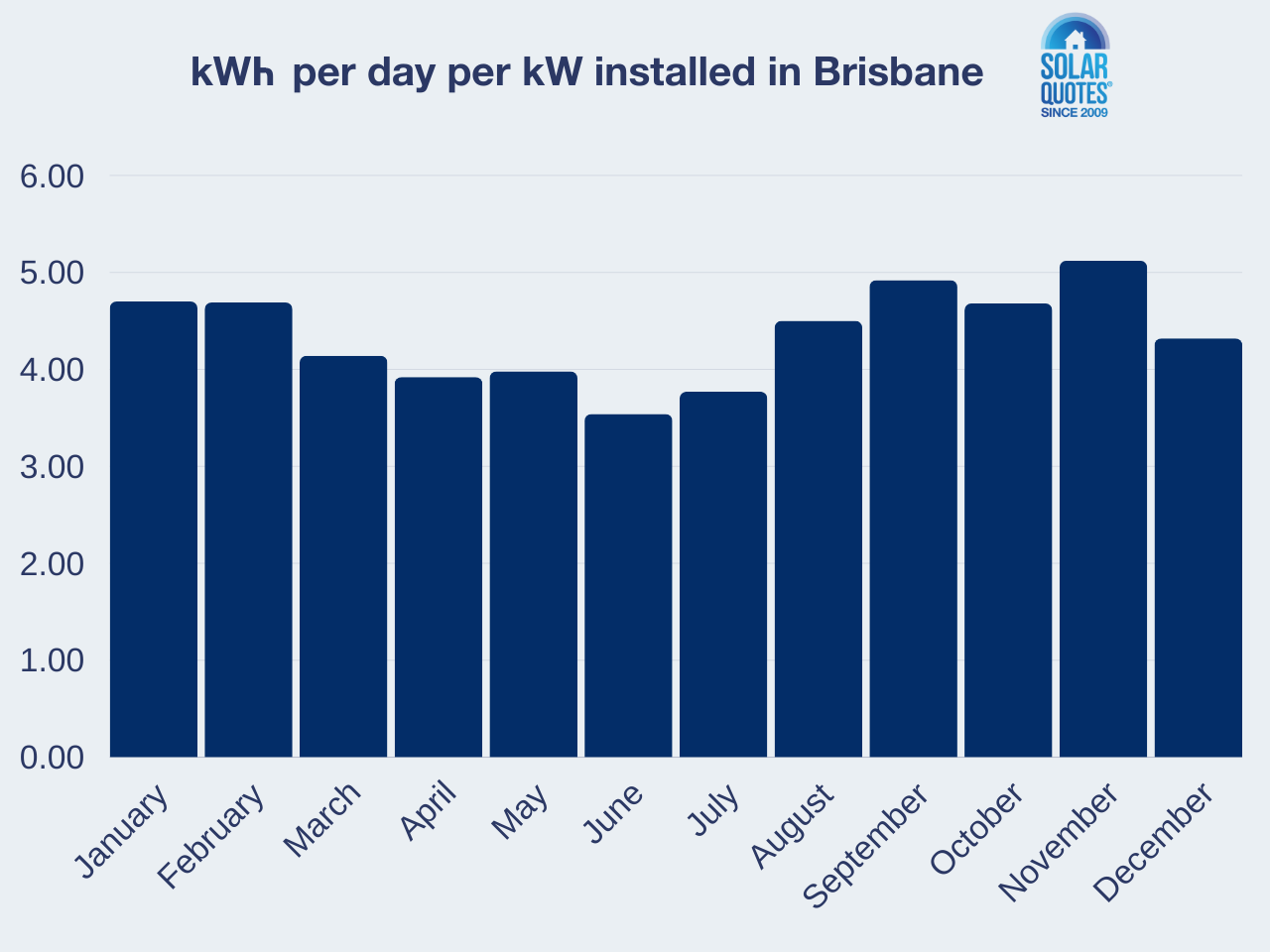Solar Energy Potential in Brisbane
Brisbane is one of the sunniest cities in Australia, making it an ideal location to install a solar array. Brisbane receives a mean of 7.4 hours of sunshine daily. A typical 6-kilowatt system on a north-facing roof can generate about 44.4 kilowatt-hours of electricity each day or 16,206 kilowatt-hours annually.
To illustrate the variation of sunshine across the year, the following graph shows the average daily kWh production per installed kW for each month.

Brisbane Climate
Brisbane has a humid subtropical climate with warm to hot weather year-round. Summers can reach highs of 29.1°C in January, while winters are mild, with lows averaging around 10.2°C in July.
Roof Angle and Solar Panel Tilt in Brisbane
In Brisbane, the best angle to install solar panels is 28°. Most Australian roofs have a pitch of 15 or 22.5 degrees, with some steeper at 30 degrees or more. The difference in output between a shallow 15-degree roof and a steep 45-degree roof is minimal. Shallow roofs slightly favour summer energy production, while steeper roofs benefit winter energy needs. Panels on a 45-degree roof produce 9% less electricity in January and 20% more in July compared to a 15-degree roof.
Solar Panel Direction and Output in Brisbane
North-facing panels generate the most electricity. However, installing east or west-facing panels can still be beneficial, particularly if they align better with your household’s electricity usage patterns. East-facing panels produce more in the morning, while west-facing panels peak in the afternoon. This can enhance self-consumption, reducing reliance on grid electricity.
Here’s a table showing how roof direction and tilt affect the output in Brisbane relative to the optimal north-facing, 30-degree orientation:
| | Flat | 10° | 20° | 30° | 40° | 50° | 60° | 70° | 80° | Vertical |
|---|
| N |
90% |
95% |
99% |
100% |
98% |
94% |
88% |
80% |
70% |
59% |
| NE |
90% |
94.5% |
96.5% |
97% |
94% |
91% |
85% |
78.5% |
70.5% |
61% |
| E |
90% |
91% |
89% |
87% |
83% |
79% |
74% |
68% |
61% |
55% |
| SE |
90% |
86.5% |
81.5% |
75% |
68% |
61% |
54.5% |
48.5% |
43% |
30% |
| S |
90% |
85% |
78% |
69% |
59% |
51% |
43% |
36% |
30% |
27% |
| SW |
90% |
86% |
80.5% |
74% |
66.5% |
57% |
53% |
47% |
41% |
36.5% |
| W |
90% |
90% |
88% |
85% |
81% |
76% |
71% |
65% |
59% |
52% |
| NW |
90% |
93.5% |
95% |
95% |
92% |
88% |
83% |
76% |
68% |
59% |
Maximum Solar System Size in Brisbane
Brisbane households with single-phase power can install systems up to 10 kilowatts (kW) with a 5 kW export limit. Homes with three-phase power can install systems up to 30 kW with a 15 kW export limit. Systems over 10 kW may require council approval. These limits refer to the inverter size, not the total solar panel capacity, allowing for oversizing – installing more panels than the inverter's rated capacity. This maximizes solar production during less optimal conditions, enhancing overall efficiency and savings.
Feed-In Tariffs in Brisbane
Feed-in tariffs in Brisbane are set by electricity retailers and vary widely. As of June 2024, rates range from 1 to 8 cents per kilowatt-hour. The right plan depends on your energy consumption and solar generation patterns. Comparing plans using tools like the SolarQuotes electricity price comparison tool can help you find the best option.
Self-Consumption of Solar Electricity
Maximising self-consumption is critical to improving the economic benefits of solar power. This can be done using appliances like dishwashers, hot water systems, and pool pumps during daylight hours. Additionally, setting air conditioners to cool or heat your home before you return can further enhance self-consumption.
Solar Uptake in Queensland
Queensland leads Australia in solar power adoption, surpassing one million solar installations in 2023. About 44% of Queensland homes have solar panels, the highest rate in the country. On average, over 150 new rooftop PV systems are installed across Queensland every day. Brisbane residents are pivotal in this solar revolution, driven by the potential for significant energy cost savings and environmental benefits.
Solar Rebates in Queensland
The sunshine state has had a fair few rebates and incentives available for its population to electrify their homes. Find out which solar rebates are available in Queensland and ask your installer about them.
Solar Power as Part of the Energy Mix in Queensland
As of 2024, rooftop systems in Queensland provide a significant portion of the state's electricity. They account for approximately 10.8% of Queensland's total electricity consumption.
Savings from Rooftop Solar Panels in Brisbane
A Brisbane household installing a 6.6 kW north-facing solar system can expect substantial savings. With a 1-cent feed-in tariff, an average Brisbane electricity price of $0.25/kWh and 40% self-consumption, annual savings can reach around $1,889.62. With a higher feed-in tariff, such as 8 cents, savings can increase to approximately $2,638.34 annually.
Conclusion
Brisbane offers excellent potential for solar energy with its sunny climate and supportive environment. By choosing a good solar installer, a suitable solar system and optimising panel placement, Brisbane residents can significantly reduce their electricity bills and contribute to a greener future.
![]() Please choose
Please choose